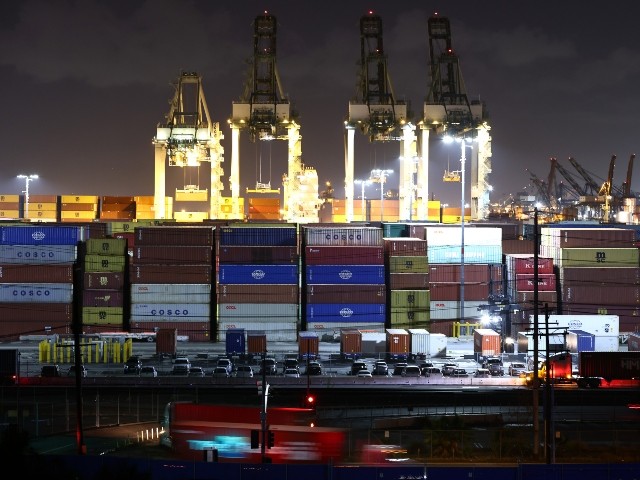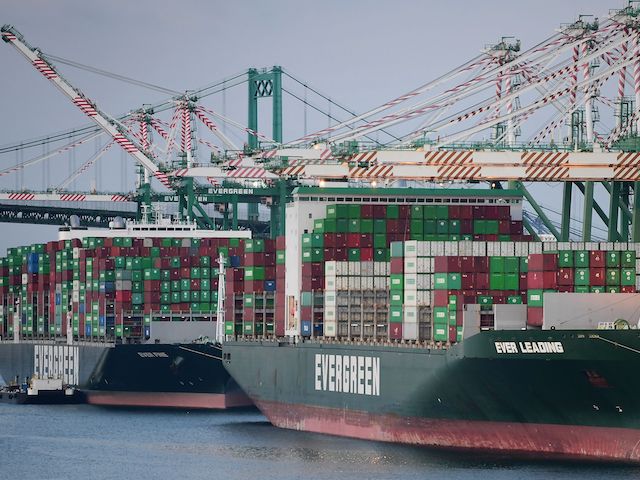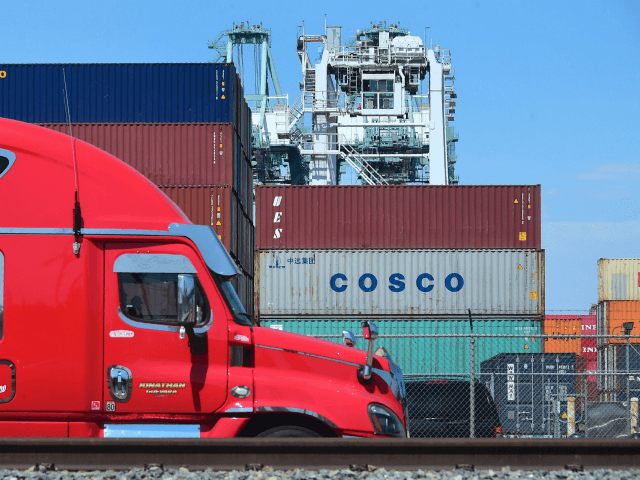A labor union is struggling to clear backlogged ports in California because too few cranes are available to move containers from ships to trucks, Business Insider reported Thursday. Yet the labor union, International Longshore and Warehouse Union (ILWU), has opposed upgrading port technology to improve efficiency.
The overflowing amount of containers on the docks has reportedly made it difficult for longshoreman to offload shipboard cargo. The ports are so full the number of cranes to move the cargo has reportedly been cut in half, along with equipment shortages.
As a result, ports are running 60 to 70 percent below capacity, Uffe Ostergaard, president of the North America region for German ship operator Hapag Lloyd told the Wall Street Journal. “That’s a huge operational disadvantage,” he explained.
A crane operator at Port of Los Angeles told Business Insider he is short seven or eight cranes to efficiently unload the massive cargo ships and avoid a port backlog.
“Companies are packing their goods into massive ships that would require seven or eight cranes to unload them at full capacity, but no terminal can handle that many cranes on the dock,” the crane operator said. “Our job is so much more difficult when the ports are congested. Most days, I’m running with only one to two crane gangs at a time.”
A part-time worker at Long Beach told Business Insider the port workers are trying to move the containers as quickly as possible but the Pacific Maritime Association (PMA), a consortium of 70 companies that negotiates and administers labor agreements, reportedly opposes paying workers overtime.

Trucks operate at the Port of Los Angeles during night operations on October 25, 2021 in San Pedro, California. The Port of Los Angeles is joining the Port of Long Beach in 24/7 operations amid efforts to ease supply chain issues. (Mario Tama/Getty Images)
“We want to work as much as possible, but the employers don’t want to pay the overtime to get these problems fixed,” the worker said. “It’s a balancing act, they want to scrape by with just enough workers, but the more ships that come in, the worse it gets.”
But the labor union, ILWU, has lost union membership over the past year, reducing the supply of port labor instead of increasing it to meet demand.
Bloomberg reported ILWU has lost 8,000 members have left in 2021 (29,000 members compared to 37,000). Business Insider reports seaports are facing a 28 percent worker shortage overall.
As the labor union has lost membership, ILWU has refused to allow the PMA to upgrade port technology. Negotiations to allow ports to increase technology to reduce the supply chain backlog are to be resolved in 2022.
“With supply chain congestion expected to continue well into next year, we are hopeful this cooperation can extend to the contract negotiations to take place between the PMA and ILWU,” PMA spokesman Randy James has stated.
ILWU claims new port equipment could “eliminate 40 to 70 percent” of union jobs but noted the “automation also creates new jobs associated with the installation and maintenance of electrified equipment, programming, and related functions.”
The lack of efficiency at the ports is a likely driver of the metastasizing supply chain crisis. Backlogs at ports are causing ships to return later then expected to Asia, where containers are waiting to be carried to the United States. What took 40 days under the Trump administration to ship items from Asia to the United States now takes 73 days.

Cargo ships filled with containers dock at the Port of Los Angeles on September 28, 2021, in Los Angeles, California. (Frederic J. Brown/AFP via Getty Images)
The delays have increased the price of shipping a container from Asia to the West Coast to $17,000. The price was $3,500 in 2020.
The price increase for shipping goods has been passed along to consumers. Food prices, for instance, have increase by 4.6 percent since 2020. More specifically, prices for meat, poultry, fish, and eggs rose 10.5 percent.
Follow Wendell Husebø on Twitter @WendellHusebø

COMMENTS
Please let us know if you're having issues with commenting.